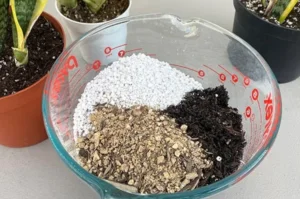Snake plants are known for being low-maintenance, tough, and beautiful indoor plants. Whether you’re a beginner or an experienced plant lover, snake plants are a great choice for your home or office. While they don’t need a lot of care, giving them the right nutrients at the right time can help them grow better and stay healthy. In this article, we’ll discuss when to fertilize snake plants, how often to do it, and some useful tips to keep in mind.
Why Fertilize Snake Plants?
Snake plants can survive in poor soil and low light, but that doesn’t mean they don’t appreciate a little extra nutrition. Fertilizing your snake plant helps in:
- Promoting healthy leaf growth
- Keeping the plant green and vibrant
- Boosting the plant’s resistance to pests and diseases
- Encouraging new shoots and faster growth
While over-fertilizing can harm the plant, the right amount at the right time can work wonders.
Best Time to Fertilize Snake Plants
The best time to fertilize snake plants is during their growing season, which is spring through summer. During this period, the plant is actively growing and can make full use of the nutrients.
Here’s a simple breakdown:
- Spring (March to May): Start fertilizing once the temperatures begin to warm up. This is when the plant wakes up from its winter rest and starts growing new leaves.
- Summer (June to August): Continue fertilizing during the warmer months when the plant is actively growing.
- Fall (September to November): Start reducing the frequency of fertilizing as the plant prepares to rest.
- Winter (December to February): Do not fertilize in winter. Snake plants go dormant during this time and won’t use the nutrients. Fertilizing during winter can harm the roots and cause fertilizer burn.
How Often Should You Fertilize?
You don’t need to fertilize your snake plant too often. These plants are slow growers and can get by with minimal feeding. A good rule of thumb is:
- Once a month during the growing season (spring and summer)
- No fertilizing in fall and winter
If your plant is healthy and growing well, you can even fertilize it every 6 to 8 weeks instead of monthly.
What Kind of Fertilizer to Use?
Snake plants are not picky, but using the right type of fertilizer helps. Here are a few suggestions:
1. Balanced Liquid Fertilizer
Use a balanced houseplant fertilizer with equal parts nitrogen, phosphorus, and potassium (e.g., 10-10-10 or 20-20-20). Dilute it to half strength before applying.
2. Succulent or Cactus Fertilizer
These are usually low in nitrogen and work well for snake plants too. They prevent overgrowth and keep the leaves firm.
3. Slow-Release Fertilizer
If you prefer not to fertilize often, a slow-release fertilizer can feed the plant gradually for several months.
How to Fertilize Snake Plants – Step-by-Step
Here’s how you can fertilize your snake plant safely:
- Water First (Optional): If the soil is completely dry, water the plant a little before applying fertilizer. This prevents root burn.
- Mix Fertilizer: If you’re using liquid fertilizer, mix it with water according to the instructions (usually at half strength).
- Apply to Soil: Pour the mixture into the soil, avoiding the leaves. Let the water drain through the pot.
- Wipe Off Spills: If fertilizer splashes on the leaves, wipe it off to avoid damage.
Signs Your Snake Plant Needs Fertilizer
If you’re unsure whether your plant needs feeding, look for these signs:
- Slow or no new growth during spring and summer
- Pale or yellowing leaves
- Weak or floppy leaves
- Roots growing out of the drainage holes
However, make sure the issue isn’t due to overwatering, poor light, or pests before deciding to fertilize.
Fertilizing Tips to Keep in Mind
- Less is More: Snake plants are sensitive to over-fertilization. It’s better to under-fertilize than overdo it.
- Use Clean Tools: Always use clean watering cans or spray bottles to prevent disease.
- Check the Soil: Avoid fertilizing if the plant is in poor soil or waterlogged conditions.
- Repotting Helps: If the plant has outgrown its pot, repotting it with fresh soil can also provide a nutrient boost.
Common Mistakes to Avoid
- Over-fertilizing: Can cause leaf burn, root damage, and stunted growth.
- Fertilizing in winter: The plant is resting and doesn’t need food.
- Using full-strength fertilizer: Always dilute it to prevent harming your plant.
Final Thoughts
Fertilizing your snake plant isn’t something you need to do often, but doing it the right way at the right time can make a big difference. Remember to fertilize only during spring and summer, use a balanced or cactus fertilizer, and avoid overfeeding. With proper care, your snake plant will reward you with beautiful, upright leaves and healthy growth.






